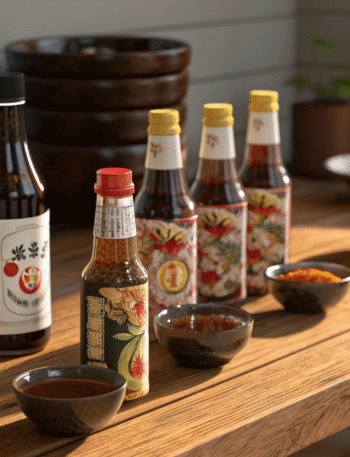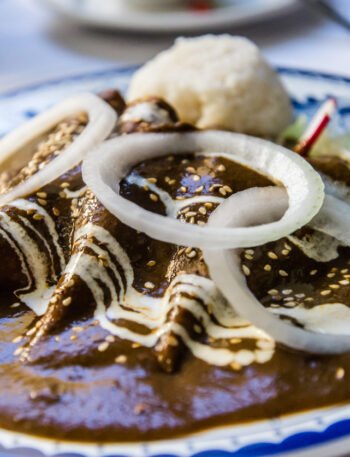Huitlacoche is one of those ingredients that surprises people the first time they hear about it and often the first time they taste it. It’s rich, earthy, and deeply flavorful, but it’s also something you might not expect to find on your plate: a fungus that grows on corn. Despite its unusual appearance and origin, huitlacoche has been treasured in Mexican cuisine for centuries. It is now gaining recognition worldwide for its unique taste and culinary versatility

My first experience with huitlacoche was at Los Danzantes, a restaurant in the Coyoacán neighborhood of Mexico City. I ordered a salad without knowing much about it, and I still remember how one bite completely changed my perception of what corn could be. The huitlacoche added an intense, almost smoky richness that made the dish unforgettable. Since then, I’ve gone out of my way to find it in tacos, tamales, quesadillas, and other dishes.
What Is Huitlacoche?
Huitlacoche (pronounced weet-la-COH-cheh) is a naturally occurring fungus that infects the kernels of corn. Once infected, the corn develops swollen, bluish-gray lumps that may look unusual at first. In English, it is often called “corn smut,” although that name technically refers to the disease caused by the fungus rather than the edible product itself. The fungus responsible is known as Ustilago maydis.
In much of the world, corn smut is seen as a crop disease. But in Mexico, huitlacoche is celebrated as a delicacy with a long history. It has a soft texture and a complex flavor that is earthy, slightly sweet, and rich in umami.
The taste of huitlacoche is often compared to mushrooms or truffles. Umami, the fifth basic taste, adds depth and savoriness to foods. Huitlacoche delivers this in a way that makes it especially appealing in both traditional and modern recipes.
A History Rooted in Tradition
Huitlacoche has deep roots in Indigenous Mexican cuisine. The Nahua people, ancestors of the Aztecs, cultivated and cooked with huitlacoche long before the arrival of Europeans. It was not viewed as a problem or mistake but rather as a seasonal ingredient with special value.
The word “huitlacoche” likely comes from the Nahuatl language, although the exact origin is debated. What is clear is that indigenous cooks have prepared this ingredient for generations. They understood its nutritional value and made it part of their food culture.
In more recent times, huitlacoche has had a mixed reputation. In many places, it has been seen as a crop disease that should be removed. However, Mexican chefs and home cooks have continued to embrace it. As more chefs around the world explore regional Mexican food, huitlacoche is gaining new respect.
Culinary Uses
Huitlacoche is a flexible ingredient with a soft texture and bold flavor. It is usually cooked with ingredients that complement or balance its richness. Here are some of the most common and creative ways it is used:

- Tacos – Huitlacoche is often sautéed with onions, garlic, and herbs like epazote, then added to warm corn tortillas. It pairs well with crema or cheese.
- Quesadillas – These are a favorite street food option, combining melted cheese and huitlacoche in a folded tortilla.
- Soups and stews – In brothy dishes, huitlacoche brings a savory depth similar to mushrooms or roasted vegetables.
- Tamales – It can be used as a filling or mixed directly into masa for a flavorful twist.
- Modern dishes – Chefs at upscale restaurants serve huitlacoche in salads, sauces, tostadas, and even pasta dishes.
Its umami quality also makes huitlacoche a great choice for vegetarian and vegan cooking, especially when looking to add richness without meat.
How It’s Grown and Harvested
Huitlacoche develops naturally when Ustilago maydis spores infect a corn plant, typically during the rainy season. In Mexico, this happens in the summer and early fall. Farmers harvest the infected corn by hand, usually before the kernels burst open.
Because it grows under specific conditions, huitlacoche is seasonal and somewhat rare. However, some farmers now grow it intentionally because of its culinary value. In the United States, a few corn producers have started cultivating huitlacoche to sell to Mexican restaurants and specialty markets.
If you cannot find it fresh, you can usually find it canned or frozen at Mexican grocery stores. Canned huitlacoche is convenient for home use, while fresh huitlacoche has a softer texture and more subtle flavor.
Nutritional Value
Huitlacoche is not only flavorful—it is also nutritious. It contains fiber, protein, and important amino acids, including lysine. This is especially important because corn alone lacks lysine. Adding huitlacoche improves the nutritional balance of a corn-based meal.
It is also low in fat and contains antioxidants, vitamins, and trace minerals. Because of these qualities, some researchers have suggested that huitlacoche could help improve nutrition in areas that rely heavily on corn.
Cooking with Huitlacoche at Home
Cooking with huitlacoche is easy once you understand its flavor. Whether you have it fresh, canned, or frozen, it works well in many dishes. Here is a simple way to prepare it:
- Sauté – Cook chopped onions and garlic in oil or butter.
- Add huitlacoche – Stir in the huitlacoche and cook until it is soft and fragrant, usually 5 to 10 minutes.
- Season – Add salt, pepper, and herbs like epazote or thyme.
- Serve – Use it in tacos, on top of rice, inside tamales, or in pasta.
Because the flavor is strong, a small amount goes a long way. Try combining it with milder ingredients to find the balance you like best.
A Growing Appreciation
Huitlacoche is now appearing on menus far beyond Mexico. It is sometimes referred to as “Mexican truffle” because of its bold, earthy flavor. Chefs in the United States, Europe, and Latin America are exploring new ways to showcase it.
This growing interest also reflects a larger movement that values Indigenous foods and traditional ingredients. More people are seeking out real flavors and looking to reconnect with food cultures that have been overlooked or misunderstood.
Final Thoughts
Huitlacoche is a great example of how something unusual can become something extraordinary. It turns a common crop into something rare and flavorful. From street tacos to elegant restaurant plates, huitlacoche adds a taste of history and a deep, satisfying richness.
If you see huitlacoche at a market or on a menu, give it a try. You may find that its bold flavor and long tradition make it one of your new favorite ingredients. It certainly became one of mine, starting with a simple salad in Coyoacán that opened the door to a whole new world of flavor.




